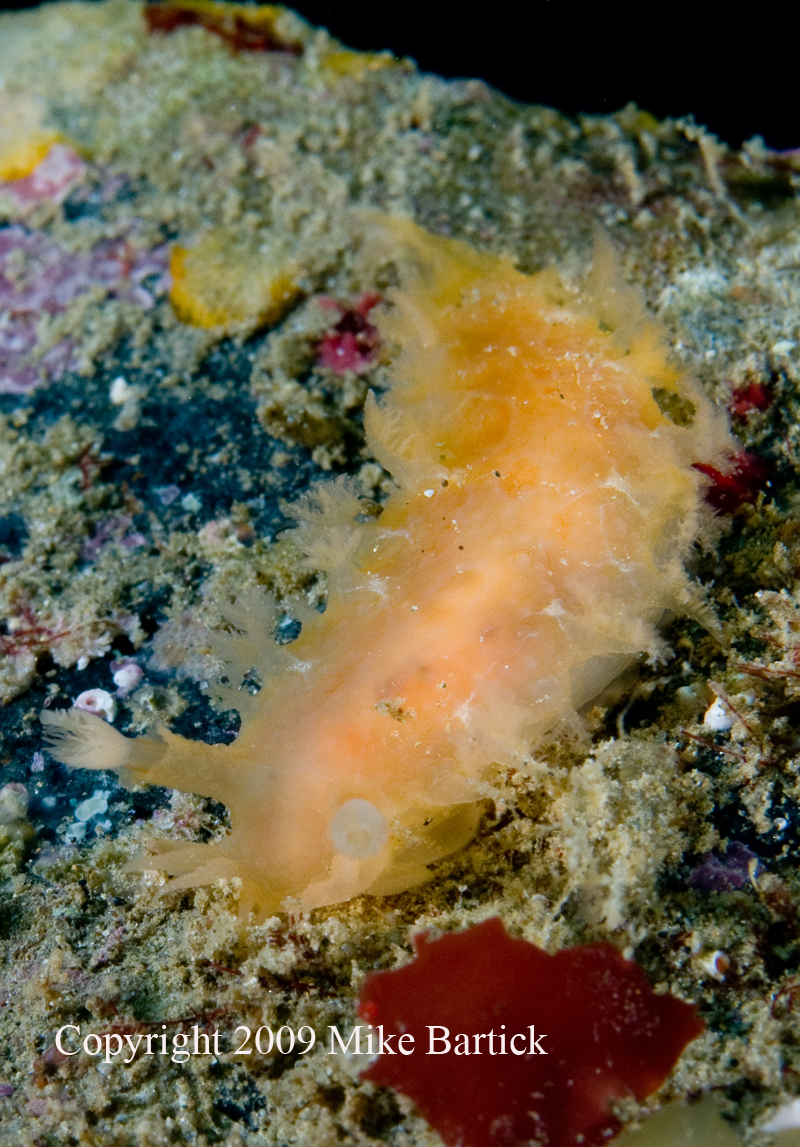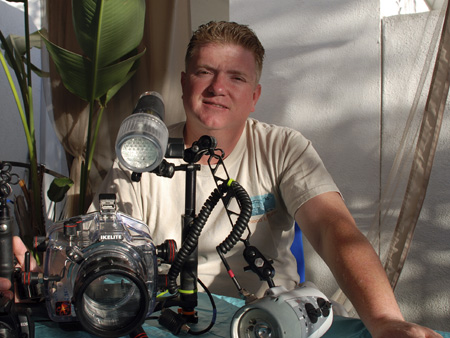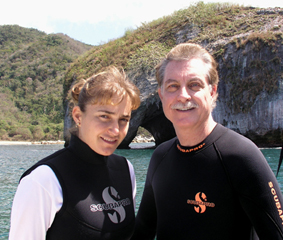 |
Tritonia festiva
Photo courtesy of Mike Bartick
Catalina Island, California
Picture taken with a Nikon D300, Sea and Sea housing, Dual YS 110 strobes-60 mm macro lense
Tritonia festiva , Stearns, 1873
One of the rarer nudibranch species on the California coast Tritonia myrakeenae is stumbled upon every once in awhile. At first most divers guess that it is a Tritonia festiva with no reticulate lines. The main differences are that this species has fewer projections on the frontal veil, and the body is pale orange with one to four distinct white patches, near the gill tufts. Specimens feed on gorgonians and octocorals, and reach up to about 18 mm in length. The species geographic range is from Santa Barbara, California to Isla Cedros off Baja California, Mexico.
Great catch Mike.
Gig Harbor, Washington
June, 2009
WEBMASTER'S NOTES (08/31/2009) Evidently Mike's guy is Tritonia festiva ! The following communication was recently received by Jeff Goddard so we are making the name change so as not to confuse folks who use this site for ID purposes!
"...You may have already gotten feedback on this one, but in case you haven't, the Tritonia in week 650 is not myrakeenae, but festiva, as evidenced by the edge of the rhinophore sheaths and much more finely branched and more numerous gill tufts; there is even evidence of the reticulating white lines typical of most festiva , as well as the rugose body surface (myrakeenae is smooth). The color of T. festiva is a matter of diet; when feeding on Clavularia, Thromobophyton and Cryptophyton, T. festiva is orangish; when feeding largely on Discophyton it's white. "
Interesting! I am going to take the low-brow approach and make the observation that all the Tritonia festiva seen in my diving experience were all white. The thought never occurred to me that they could come in different color shades! Keep an open mind folks!
Send Jeff email at goddard@lifesci.ucsb.edu
San Diego, CA
Aug., 2009
Mick Bartick after dive on oil rigs (California)
 |
Mike Bartick is an avid and experienced scuba diver and Marine Wildlife Photographer residing in southern California. Mike admits that while he is a world traveling diver, the northern Channel Islands are amongst his favorite dive spots he has ever experienced. I have always been the fish in our family, loving the ocean and lakes; to swim and be free, floating in a liquid world. Gliding through the kelp forests, experiencing and discovering wild animals in the universe below, sharing through photography, is a dream come true. My love of photography comes from my father. As long as I can remember he always had his camera ready in hand. Given to me by my parents when I was in the eight grade, my first camera was a brownie box camera. |
Mike started shooting underwater with a friend's Minolta 110 at around fifteen years of age. While it was a film camera, there were a lot of "learning curve" shots and he started shooting less and less. When the digital camera age hit, he decided to start shooting more because of the new dynamics it brought to underwater photography.
Nothing about shooting in a liquid medium is easy. There is surge, ever changing light conditions and bursts of bubbles which scare fish off easily. Finding your subject is often times very difficult and once located, sometimes impossible to work with. Great macro shots require a perfect balance of light and skill. The lense is within inches of the subject. Generally higher F-stops and longer exposures make this type of photography difficult underwater. Lighting is extremely important. Overexposure kills, underexposure is just as bad. Perfectly lit subjects will glow with hand painted clarity and detail. The deeper you go, the less color you will have, and an experienced underwater photographer will always instinctively know what he is looking at and how to light it.
Mike has just published an article on our recent trip to the Philippines and aptly named, "Going Nudi in Anilao" Mixed media adds a nice dynamic with a slide show of various other Non-featured photos.
Find the article here:
http://www.divephotoguide.com/articles/going_nudi_in_anilao
Marine Wildlife Photography
www.saltwaterphoto.com
Send Mike email at Mike@saltwaterphoto.com
March 2005

Ali Hermosillo and Dave Behrens
Author:
Pacific Coast Nudibranchs
Send Dave mail at dave@seachallengers.com
|
